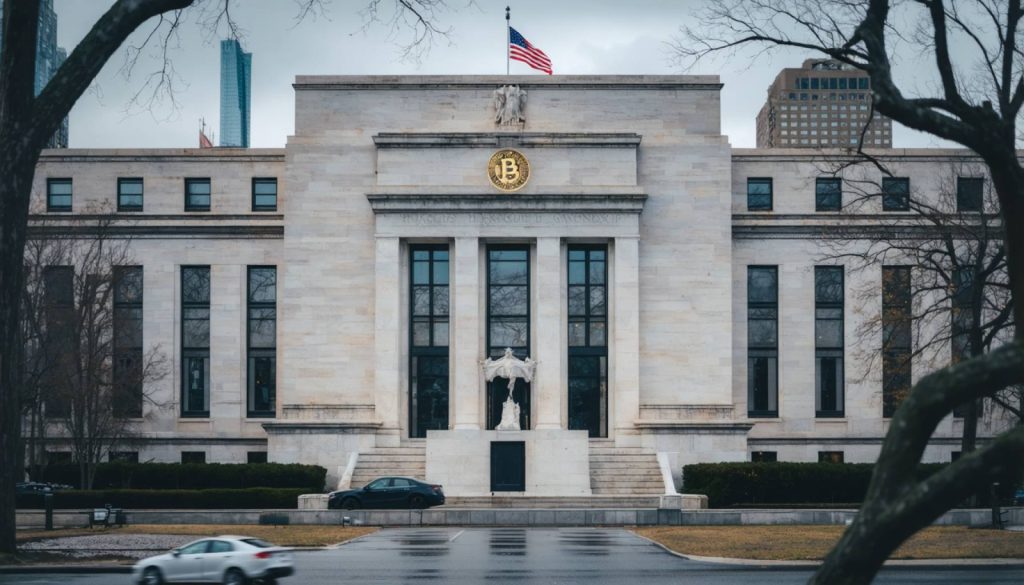
- Cryptocurrency markets face turbulence, with Bitcoin, Ethereum, and Ripple experiencing significant drops following new tariffs announced by Trump.
- Global stock markets are affected, as the Nasdaq, S&P 500, and Dow Jones each see considerable declines.
- Trump’s tariffs on China and the EU, along with steel and aluminum, fuel recession fears and major economic debate.
- Over $1 trillion has been wiped from the cryptocurrency market, now valued at $2.6 trillion.
- Historical comparisons suggest Federal Reserve intervention could stabilize markets, reminiscent of responses to past crises.
- Potential Federal Reserve actions, such as interest rate cuts, could avert recession, while Trump might turn to economic stimulus.
- Investors are poised for opportunity, expecting fortunes to arise from economic recovery scenarios.
A tempest brews in the financial markets as cryptocurrencies continue their turbulent descent, triggered by the reverberating crack of newly imposed tariffs. Donald Trump’s latest “Liberation Day” speech cast a shadow across global economies, sending the crypto and stock markets into a nosedive. As Bitcoin teeters near the psychological support level of $80,000 after a 3.5% fall, Ethereum tumbles to $1,765, and Ripple slips past its critical $2 threshold, investors are left wondering where the bottom might be.
In this volatile landscape, the fear and greed index plummets, reflecting an air of uncertainty gripping stakeholders. Over $1 trillion has vanished from the broader cryptocurrency market, whose total valuation now stands at a diminished $2.6 trillion. The crypto turmoil interlinks seamlessly with broader economic tremors, as the Nasdaq dips 4.7%, the S&P 500 sneaks down 3.78%, and the Dow Jones follows with a 3.4% decrease. The resonance of Trump’s speech reaches beyond borders, triggering fears that these tariffs could catalyze a recession in multiple countries.
The depth of Trump’s tariffs—hitting China and the European Union with a hefty 34% and 24% respectively, alongside a cascading 25% on steel, aluminum, and parts—has ignited debate. A prominent analyst cautions that these measures could spell a deeper economic wound than mere stagflation, potentially ushering in a recession—a scenario increasingly feared within the prognosticative circles of Polymarket.
Comparisons to past financial crises emerge. In 2008, risky assets plummeted amid the global financial chaos, yet the Federal Reserve’s intervention reignited growth. Similarly, during the dawn of the COVID-19 pandemic in 2020, the Fed’s decisive slashing of interest rates led to a robust rebound in both stocks and cryptocurrencies. History whispers that intervention is key.
In the current climate, speculation suggests that the Federal Reserve might once again pull the economy back from the brink. The possibility of accelerating interest rate cuts looms should recession signals flash prominently. Trump could even pivot toward economic stimulus, injecting rescue funds into beleaguered sectors like agriculture, potentially inflating asset prices once more.
Investors hold their breath in this high-stakes game of financial chess, mindful that the greatest fortunes often arise in times of economic strife. The market’s narrative remains unwritten, poised on the precipice of intervention or intensified turmoil. As the Federal Reserve contemplates its next move, uncertainty reigns supreme, yet a lurking optimism persists among seasoned investors ready to capitalize on recovery should the tide turn.
Navigating the Cryptocurrency Storm: Strategies and Insights for Investors Amid Global Market Turmoil
As the financial markets reverberate from newly imposed tariffs and geopolitical tensions, cryptocurrencies find themselves under significant pressure. Prices for popular cryptocurrencies like Bitcoin, Ethereum, and Ripple have nosedived as a result of Donald Trump’s recent “Liberation Day” speech, which signaled hefty tariffs that could ripple across global economies. Let’s break down additional facts and insights surrounding this tumultuous period and explore strategies for navigating the current market.
The Current State of Cryptocurrencies and Global Markets
1. Cryptocurrency Market Overview: With over $1 trillion wiped off the crypto market, now valued at $2.6 trillion, investors are contemplating whether this is a temporary blip or a more prolonged downturn.
2. Stock Market Impact: Major indices such as the Nasdaq, S&P 500, and Dow Jones experienced significant downturns, declining by 4.7%, 3.78%, and 3.4% respectively.
3. Global Economic Concerns: The tariffs targeting major economies like China and the EU could indeed initiate a recession, highlighting the interconnected nature of financial markets.
Historical Context and Potential Interventions
– Historical parallels are often drawn with past financial crises. In 2008 and 2020, interventions by the Federal Reserve, through measures like slashing interest rates, prompted recoveries. As history suggests, market interventions can be pivotal in restoring stability.
Insights and Predictions
– Federal Reserve’s Role: Speculation surrounds whether the Federal Reserve will intervene by cutting interest rates or implementing other supportive measures. If recession indicators grow stronger, Fed action could catalyze market recovery.
– Potential Stimulus Measures: There is also speculation about Trump potentially resorting to economic stimulus to alleviate industry pressures, especially within agriculture, which could subsequently buoy asset prices.
Strategies for Investors
Here are some actionable strategies and insights for investors seeking to navigate the uncertainty:
– Diversification: Spread investments across multiple asset classes to mitigate risk. In turbulent times, having a well-rounded portfolio can protect against downside risks.
– Stay Informed: Keep abreast of policy changes and market signals. Staying informed about economic policy shifts can help anticipate market movements.
– Long-Term Perspective: Consider a long-term investment strategy, focusing beyond short-term volatility and potential downturns.
– Risk Management: Utilize stop-loss orders and other risk management tools to protect investments from severe market fluctuations.
Future Trends and Considerations
– Cryptocurrency Adoption: Beyond the current downturn, the future of cryptocurrencies still hinges on technological adoption and regulatory frameworks.
– Tech and Innovation in Finance: Financial technology (FinTech) innovations continue to reshape how investments are made and managed, potentially introducing new opportunities.
Final Thoughts and Recommendations
Investors facing the current market storm should remain vigilant and adaptable. By employing strategic diversification and risk management, investors can better position themselves to capitalize on recovery when it manifests.
For further insights and updates on financial trends, visit Bloomberg and Coindesk to stay informed on global market dynamics.
In conclusion, while uncertainty prevails, it is also a time for keen observation and strategic planning. By focusing on historical lessons and potential interventions, investors can navigate chaos and potentially harness the opportunities that economic unpredictability often presents.



